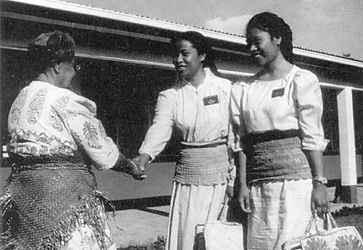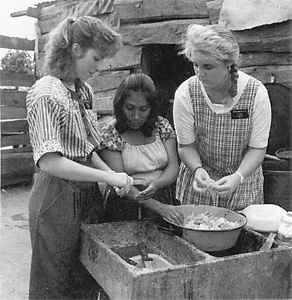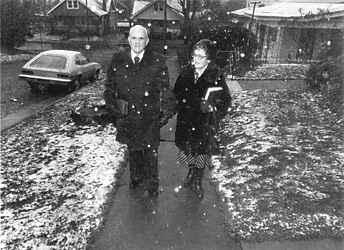
Missions |

Many single women, such as these two in Tonga, 1986, fulfill missions. All single missionaries live and work with a companion of the same sex. Courtesy Floyd Holdman.
by Dean B. Cleverly
The mission of THE CHURCH of JESUS CHRIST of Latter-day Saints is to invite everyone to come to Christ. This includes a mandate to proclaim the gospel of Jesus Christ to every nation, kindred, tongue, and people (cf. Matt. 28:19; Mark 16:15; D&C 42:58). "Therefore, go ye into all the world; and unto whatsoever place ye cannot go ye shall send, that the testimony may go from you into all the world unto every creature" (D&C 84:62). From the earliest days of the Church, missionaries have been called to the nations of the earth to preach that message.
The ultimate destiny of missionary work was envisioned by the Prophet Joseph Smith in 1842:
Our missionaries are going forth to different nations…. The Standard of Truth has been erected; no unhallowed hand can stop the work from progressing; persecutions may rage, mobs may combine, armies may assemble, calumny may defame, but the truth of God will go forth boldly, nobly, and independent, till it has penetrated every continent, visited every clime, swept every country, and sounded in every ear, till the purposes of God shall be accomplished, and the Great Jehovah shall say the work is done [HC 4:540].
Two basic types of missions are organized to carry forward the missionary effort: full-time missions and stake missions.
FULL-TIME MISSION. A full-time mission is an ecclesiastical unit of the Church in a designated geographical area. A mission president and his wife are called to preside over the mission and supervise from 120 to 250 full-time missionaries. Small missions in newly opened areas begin with fewer missionaries. In areas where stakes have not yet been established, the mission president also bears ecclesiastical responsibility for all Church members who live within the boundaries of his mission. In areas where stakes have been established, the mission president does not carry this responsibility but is available as a resource to help members advance missionary work. Full-time missions have been organized in nations wherever the Church has official recognition.
STAKE MISSION. A stake mission is organized in each stake of the Church to supplement or extend the resources of the full-time mission in that area. A stake mission president and two counselors preside over the stake mission. Unlike full-time missionaries, stake missionaries serve part-time, mostly in the evenings, and continue to live in their own homes and to fulfill their normal family and occupational responsibilities. They are generally expected to spend ten or more hours a week doing missionary work.
President Spencer W. Kimball described missionary work as the lifeblood of the Church. He wrote,
If there were no converts, the Church would shrivel and die. But perhaps the greatest reason for missionary work is to give the world its chance to hear and accept the gospel. The scriptures are replete with commands and promises and calls and rewards for teaching the gospel. I use the word command advisedly, for it seems to be an insistent directive from which we, singly and collectively, cannot escape. Furthermore, the command is clear that not only must all members of His church give missionary service, but we must take the gospel to all the children of our Heavenly Father on this earth [p. 4].
HISTORY OF MISSIONARY WORK. In April 1830, immediately after the Church was organized, the first formal missionary activity began. Samuel H. Smith, a brother of the Prophet Joseph, filled his knapsack with copies of the Book of Mormon and traveled through neighboring towns in upstate New York to acquaint people with the newly published book of scripture. He sold a copy to Phinehas H. Young, who read the book and later joined the Church. The same book came into the hands of Brigham Young and, in conjunction with additional contacts, led to his conversion.
In the fall of 1830, four brethren, Oliver Cowdery, Peter Whitmer, Jr., Parley P. Pratt, and Ziba Peterson, were called to undertake a mission to the western frontier to preach to the Lamanites. They met with several Indian tribes, but their work was hampered by government Indian agents, and their principal success was among the white settlers in Ohio (see Lamanite Mission). By the end of December 1830, several hundred people had joined the infant Church, including such leaders as Sidney Rigdon and Frederick G. Williams, later named as counselors to Joseph Smith, and Edward Partridge, its first Presiding Bishop.
Through the efforts of several beginning in 1830, missionary work extended into Canada. John Taylor, who later became the third President of the Church, was an early convert there in the spring of 1836.
In 1837 Heber C. Kimball was called to open the first mission abroad. He and Orson Hyde were set apart to begin the work in the british isles. In that same year, Parley P. Pratt issued his pamphlet Voice of Warning, the first tract published for missionary use in the Church. In April 1839, in response to revelation (D&C 118), the Quorum of the Twelve Apostles and others departed for a mission to Great Britain (see Missions of the Twelve to the British Isles). Thousands of converts joined the Church, and great numbers of them emigrated to America during the 1840s and strengthened the Church as it endured dissension within and persecution from without.
By the 1850s, missions had been opened in Chile, France, Germany, Gibraltar, Hawaii, India, Italy, Malta, Scandinavia, South Africa, the South Pacific, and Switzerland. Many of these were discontinued after only a few years; but in the final decades of the nineteenth century, a time when the Church was facing severe persecution and extreme financial difficulties, additional missions were founded in Mexico, Samoa, Tahiti, and Turkey.
In 1901, President Lorenzo Snow renewed the emphasis on taking the gospel into all the world. Heber J. Grant of the Quorum of the Twelve Apostles dedicated Japan for the preaching of the gospel. Over the next two years, Francis M. Lyman, also of the Twelve, dedicated the lands of Africa, Finland, France, Greece, Italy, Palestine, Poland, and Russia for missionary work.
In 1920-1921, David O. McKay of the Twelve traveled some 56,000 miles in a world survey of Church missions for the First Presidency. He made stops in the Pacific islands, New Zealand, Australia, Asia, India, Egypt, Palestine, and Europe. While in Asia, he dedicated China for the preaching of the gospel.
In December 1925, Melvin J. Ballard of the Twelve established a mission in South America, with headquarters in Buenos Aires, Argentina, predicting, "The work of the Lord will grow slowly for a time here just as an oak grows slowly from an acorn. It will not shoot up in a day as does the sunflower that grows quickly and then dies. But thousands will join the Church here. It will be divided into more than one mission and will be one of the strongest in the Church. The work here is the smallest that it will ever be. The day will come when the Lamanites in this land will be given a chance. The South American Mission will be a power in the Church" (quoted in Melvin J. Ballard: …Crusader for Righteousness [Salt Lake City, 1977], p. 84). By 1990, Central and South American converts had emerged as one of the largest segments of the Church.
During President McKay's administration as President of the Church, he instituted a vigorous missionary effort that increased the number of full-time missionaries from 5,000 to 13,000 and soon transformed the Church from an American institution into an international one. Preparation and training for missionaries were formalized and intensified. The first seminar for mission presidents was held in June 1961. A new teaching plan of six lessons was introduced and his "every member a missionary" program coordinated missionary efforts of Church members. In November 1961 a language training institute was established at Brigham Young University in Provo for missionaries called to Spanish-speaking missions. This institute became the Language Training Mission in 1963 and the missionary training center in 1978. During the 1960s and the 1970s, the Church built visitors centers at many temple sites and other locations, including major pavilions for the New York World's Fair in 1964-1965 and the expositions in San Antonio, Texas, in 1968; Japan in 1970; and Spokane, Washington, in 1974. A large visitors center was opened on Temple Square in August 1966.
In April 1974, in his first major address as President of the Church, Spencer W. Kimball emphasized that every able, worthy young man should serve a mission. Under his leadership, the missionary force more than doubled in twelve years, and new missions were established in many parts of the world. The June 1978 revelation extending the priesthood to all worthy male members of the Church opened up additional missionary opportunities (see Doctrine and Covenants: Official Declaration--2).
Ezra Taft Benson, who became the thirteenth President of the Church in November 1985, continued to emphasize proclaiming the gospel as an important and basic part of the mission of the Church, emphasizing the role of the Book of Mormon as a necessary and powerful tool.
Changing political conditions throughout the world in the final decades of the twentieth century opened nations previously inaccessible to missionaries—principally in Africa, Asia, and Central and Eastern Europe.
MISSIONARY ORGANIZATION. Under the direction of the First Presidency, the Quorum of the Twelve Apostles is the Missionary Committee of the Church. The members of the Twelve "are called to be the Twelve Apostles, or special witnesses of the name of Christ in all the world,…being sent out, holding the keys, to open the door by the proclamation of the gospel of Jesus Christ" (D&C 107:23, 35). The Twelve are assisted in their ministry by the seventy, who "are also called to preach the gospel, and to be especial witnesses unto the Gentiles and in all the world" (D&C 107:25).
The Missionary Department is the staff organization at Church headquarters that assists the Missionary Committee of the Church in providing direction, training, programs, resources, and administrative support to the missions of the Church. Calls to full-time missionaries are processed through the Missionary Department.
A mission president is called by the First Presidency to preside over each mission of the Church, normally for three years (see Mission President). He calls two full-time missionaries as his assistants, and they help him in training and supervising other missionaries. In his stewardship of Church units, the mission president is generally assisted by two local counselors. These counselors help the mission president in training and coordinating with local priesthood leaders and members who live within the stakes and wards within the mission area.
CALLS TO MISSIONARY SERVICE. In 1842, Joseph Smith summarized the procedure for calling a person to serve in the Church: "We believe that a man must be called of God, by prophecy, and by the laying on of hands by those who are in authority, to preach the Gospel and administer in the ordinances thereof" (A of F 5).
In the early days of the Church, missionaries were called individually during Church conferences. After the Saints moved to the Salt Lake Valley, the First Presidency announced mission calls at general conferences—often to the surprise of those called. Later, written calls were sent from the office of the President of the Church. The return address on these letters was simply Box B, Salt Lake City, Utah, and for generations of Latter-day Saints, "Box B" became a symbol of the call to serve a mission.
At first, mission calls were issued to anyone, and married men often left their wives and children to serve for an unspecified period of time, ranging from a few weeks to several years. During the latter half of the nineteenth century and the first quarter of the twentieth, wives occasionally accompanied their husbands on missions. The first calls to single women were issued near the end of the nineteenth century.
The ages and terms of service of full-time missionaries have varied over the years, and exceptions are made according to circumstance. In 1990, unmarried men ages nineteen through twenty-five, or occasionally older, were called to serve for twenty-four months. Unmarried women ages twenty-one through thirty-nine were called to serve for eighteen months, and those age forty through sixty-nine were called to serve for twelve months. Married couples normally served for either twelve or eighteen months.
In addition to the traditional tasks of missionaries, couples and sister missionaries may also be given assignments in such areas as leadership training, mission office staff, visitors center staff, public communications, temple work, family history research, health Welfare Services, education, and other full-time Church service.
MISSIONARY PREPARATION AND TRAINING. Informal missionary training often begins in the homes of Latter-day Saints and continues in the various Church priesthood and auxiliary organizations at the local level. A specific purpose of bearing the Aaronic Priesthood, designated in the scriptures as the preparatory priesthood (D&C 84:26), is to prepare young men for the responsibilities of the Melchizedek Priesthood, including missionary service. Some stakes sponsor missionary-preparation seminars or classes to assist young men and women and older couples in preparing for full-time missions. Brief formal missionary training for those already called is given at local Missionary Training Centers located around the world. Missionaries assigned to missions where they will speak their native language remain at a training center for approximately three weeks. Missionaries who must learn a new language remain for approximately two months (see Missionary Training Centers).
On arrival in an assigned field of labor, each missionary receives on-the-job training from a senior companion and other mission leaders. Each missionary pair or married couple spends a portion of each day studying the scriptures, practicing the missionary discussions, and strengthening other missionary skills and attributes. Language study also continues for those who are learning a new language. District meetings held every week and zone conferences held every four to six weeks provide opportunities for missionaries to be instructed, motivated, and further trained by the mission leaders.
MISSIONARY APPROACHES. Historically, missionaries have endeavored to find those who are interested in listening to their message so they can teach them the gospel, baptize those who desire to join the Church, and fellowship new converts as they begin their membership in the Church.
During the first 150 years of the Church, missionary work centered on public meetings and contacting people in their homes: tracting (see below); street meetings; debates; exhibits at fairs, expositions, or shopping malls; firesides held in public buildings or Church meetinghouses; and "cottage meetings" held in private homes.
Door-to-door contacting is commonly called "tracting" because missionaries in the past often left printed tracts with people as they called on them. As the number and influence of Church members have grown, missionaries have come increasingly to rely on referrals from members to find people to teach. In the latter half of the twentieth century, missionaries have had the benefit of standardized lessons, usually referred to as missionary discussions, to assist them in teaching the gospel.
People who are being taught are invited to become actively involved by reading and studying on their own, praying about the message they are receiving, attending Church meetings, coming to know Church members, and living the principles of the gospel as they learn them. Full-time and stake missionaries are often assigned specific duties in shepherding new members and helping them become "fellowcitizens with the saints, and of the household of God" (Eph. 2:19).
Illustrations

Among the full-time missionaries of the Church is a group of young women (approximately 270 in 1990) with health and teaching backgrounds who are assigned to teach disease prevention, nutrition, and home health care to Church members in developing countries in addition to fulfilling proselytizing responsibilities.

In recent years, more and more retired couples have chosen to serve missions together. As of 1991, approximately 1,500 couples were serving on a full-time voluntary basis. In addition to sharing the gospel with non-members, many missionary couples have assignments in leadership training, public relations, and family history. Some serve in Church visitors centers or in mission offices. Couples called to work in temples and in Church schools devote full time to these responsibilities and are not involved in proselytizing. Photograph, c. 1980, Deseret News.
Bibliography
Kimball, Spencer W. "It Becometh Every Man." Ensign 7 (Oct. 1977):3-7.
Encyclopedia of Mormonism, Vol. 2, Missions
Copyright © 1992 by Macmillan Publishing Company
All About Mormons |